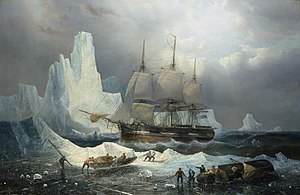
Back HMS Erebus (1826) Catalan HMS Erebus (1826) Czech HMS Erebus (1826) German HMS Erebus Esperanto HMS Erebus (1826) Spanish HMS Erebus (1826) Basque اچاماس اربوس (۱۸۲۶) Persian HMS Erebus (1826) Finnish HMS Erebus (1826) French אה"מ ארבוס (1826) HE
 Erebus in the Ice, 1846, by François Musin
| |
| History | |
|---|---|
| Name | HMS Erebus |
| Namesake | Erebus |
| Ordered | 9 January 1823 |
| Builder | Pembroke Dock, Wales |
| Laid down | October 1824 |
| Launched | 7 June 1826 |
| Fate | Abandoned 22 April 1848, King William Island |
| Wreck discovered | 2 September 2014, Wilmot and Crampton Bay |
| General characteristics | |
| Type | Hecla-class bomb vessel |
| Displacement | 715.3 long tons (727 t)[1] |
| Tons burthen | 372 tons (bm) |
| Length | 105 ft (32 m) |
| Beam | 29 ft (8.84 m) |
| Installed power | 30 Nominal horsepower[2] |
| Propulsion | Sail, steam engine |
| Complement | 67 |
| Armament | |
| Official name | Wrecks of HMS Erebus and HMS Terror National Historic Site |
| Designated | 2019 |
HMS Erebus was a Hecla-class bomb vessel constructed by the Royal Navy in Pembroke dockyard, Wales, in 1826. The vessel was the second in the Royal Navy named after Erebus, the personification of darkness in Greek mythology.
The 372-ton ship was armed with two mortars – one 13 in (330 mm) and one 10 in (254 mm) – and 10 guns. The ship took part in the Ross expedition of 1839–1843, and was abandoned in 1848 during the third Franklin expedition. The sunken wreck was discovered by the Canadian Victoria Strait expedition in September 2014.[3]
- ^ Bourne, J. (1852). "Dimensions of screw steam vessels in Her Majesty's Navy". A treatise on the screw propeller. London: Longman, Brown, Green, and Longmans. OCLC 937353412.
- ^ Murray, R. (1852). Rudimentary treatise on marine engines and steam vessels. London: J. Weale. p. 206. OCLC 249509737.
- ^ Cite error: The named reference
Cbc2014-09-27was invoked but never defined (see the help page).
© MMXXIII Rich X Search. We shall prevail. All rights reserved. Rich X Search